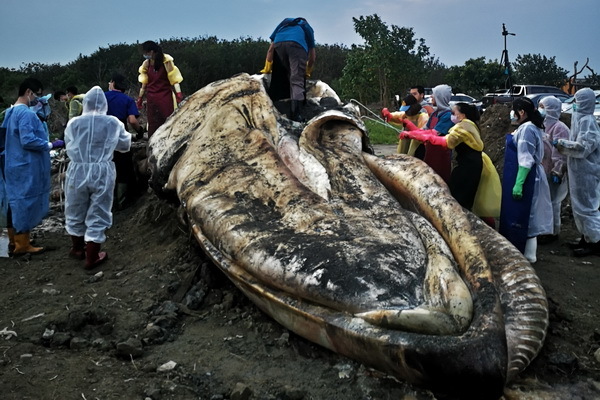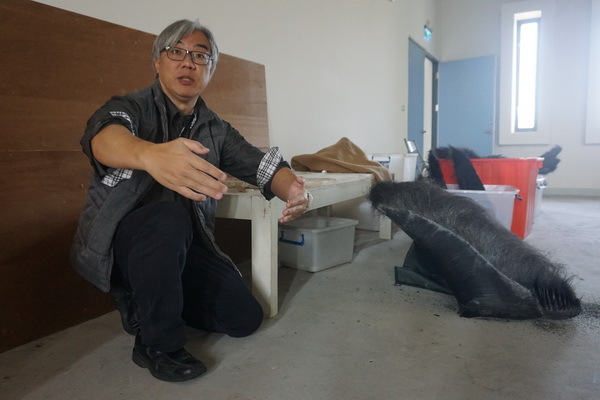Marine Biology and Cetacean Research Center Does Its Best to Preserve the Blue Whale’ s Skeleton.
Cleaning bones and getting rid of rotten meat of a blue whale, the largest animal around the world, Marine Biology and Cetacean Research Center (MBCRC), National Cheng Kung University, is now carrying out an unprecedented mission of Taiwan. Floating on the ocean, the carcass of a blue whale was stranded on Taitung’s seashore in January, 2020. According to the necropsy, the main structure of this young whale’s skull is severely crushed. Thus, it will be a tough task of making a skeleton specimen in the future.

There are no past records of blue whales in Taiwan
“No one had ever witnessed any living or beached blue whale much more than half century in the ocean around Taiwan. According to the documents of whaling activities in the past 100 years of Taiwan area, 14 blue whales were caught in the ocean around Taiwan during 1920-1938; however, there were no exact locations of catching whales on records,” said Prof. Hao-Ven Wang, Director of MBCRC. There are no records of the appearance of blue whales around Taiwan during the past decades, either. Based on official records, although there are nearly 30 species of cetacean in the ocean around Taiwan, the blue whale is not one of them. Apart from investigating the cause of death, MBCRC also aims to preserve the skeleton of the blue whale as much as they can and make it into a specimen. It will be a significant contribution to whale research for the whole world, if the skeleton specimen is successfully made.
Based on the evidence of the necropsy, the age of this blue whale is less than three years old. Moreover, the research papers point out that the calf is born at 7 meters in length, at 15 meters after seven months and reaches a maximum confirmed length of 30 meters. The longevity for a blue whale is at least 80-90 years and some may even reach 110 years.
Prof. Hao-Ven Wang pointed out that this is the first record that a blue whale stranded in Taiwan for nearly ten decades. Currently, only few countries (e.g. Canada, America, and Britain) own blue whale’s skeleton specimen and this one will be the first specimen of blue whale in Taiwan.

Hao-VenWang explains cetacean research
When it mentioned to the process of dissecting with the beached blue whale, Prof. Wang said sadly, “this blue whale was starving!” Its organs were rotted, and its muscles decomposed into watery- bloody- fluid. There were no food residues found in its stomach and intestines. In addition, its subcutaneous blubber layer was thin which proved that it hadn’t eaten anything for a long time.
“We feel very sorry that this blue whale’s mouth was twined by fishing net when we found it in Changbin, Taitung. With its mouth open, the blue whale takes in large volumes of water into its chin. Closing its mouth and squeezing out the water with its abdomen at the same time, its food, such as krill or fish, will be filtered through its baleen plates. Thus, if the blue whale cannot open its mouth, it cannot eat anything,” said Prof. Wang. Although the cause of the blue whale’s death is related to fishing industry, with limited information, the research group has not yet identified to which fishing method the fishing net was categorized. Nowadays, the world begins to reflect on the importance of friendly fishing gear and fishing industry. The United Nation Sustainable Development Goals (SDGs)14 also mentioned issues of “increased efforts and interventions are needed to conserve and sustainably use ocean resources at all levels.” Therefore, Prof Wang feels that he is responsible for exploring and realizing the cause of the blue whale’s death. Finally, Prof. Wang expects the proof he finds will raise awareness about issues critical to the protection of life below water.
Provider:
News Center
Date:
20209-04-01




